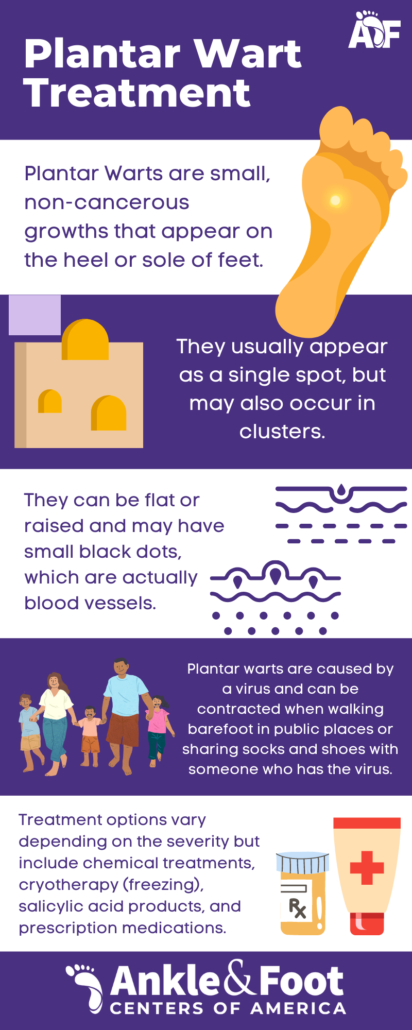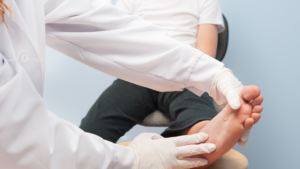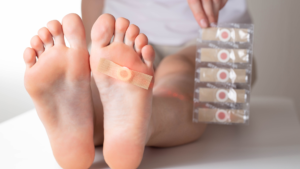Plantar Wart Treatment
Are you tired of dealing with the pain and discomfort caused by warts on your feet? Plantar warts can be a persistent and bothersome issue, but don’t worry – we’re here to help you navigate the world of plantar wart treatment and removal. In this article, we’ll explore the causes, symptoms, and various treatment options for plantar warts, so you can confidently take the first steps towards healthier, happier feet.
Definition of Plantar Warts
Plantar warts are small, rough growths that typically develop on the bottom of your feet, particularly in areas subjected to pressure, such as the heel or ball of the foot. These warts are caused by the human papillomavirus (HPV) and can vary in size and appearance. While some plantar warts may be harmless, others can become painful and even affect the way you walk.
Importance of Plantar Warts
Treating plantar warts is essential not only for your comfort but also for preventing the spread of the virus. Left untreated, warts on feet can grow larger, multiply, and even spread to other areas of your body or to other people. Additionally, ignoring a wart on your toe or the bottom of your foot can lead to changes in your gait, potentially causing further pain or discomfort. By addressing plantar warts early and following an appropriate treatment plan, you can effectively reduce pain, minimize the risk of infection, and regain your confidence.
Causes and Symptoms of Plantar Warts
Understanding the causes and symptoms of plantar warts is crucial in identifying and addressing the issue early on. In this section, we’ll dive into how warts on feet develop, and how to recognize the telltale signs of a wart on your foot or toe.
How Warts on Feet Develop
Plantar warts are caused by the human papillomavirus (HPV), which enters the body through tiny cuts, breaks, or weak spots on the skin of your feet. HPV thrives in warm, moist environments, making public showers, swimming pools, and locker rooms common places for transmission. Once the virus has entered your skin, it can cause a rapid growth of cells on the outer layer, resulting in a wart.
Identifying a Wart on Foot
A wart on your foot can be identified by its distinct appearance and location. Plantar warts are typically small, rough, and grainy, with a hard, thickened skin surrounding the area. You may also notice tiny black dots within the wart, which are clotted blood vessels. Most commonly, these warts appear on the bottom of the foot, where pressure is exerted during walking or standing.
Recognizing a Wart on Toe
A wart on your toe can be similar in appearance to warts on the bottom of the foot, with a rough, grainy texture and small black dots. However, due to its location, a wart on your toe may be more prone to irritation from footwear and may cause discomfort while walking. It’s important to differentiate a wart from a corn or callus, which are caused by friction and pressure, rather than a viral infection.
Common Signs of a Wart on Bottom of Foot
The most common signs of a wart on the bottom of your foot include:
- Pain or tenderness while walking or standing
- A hard, thickened area of skin with a rough, grainy texture
- Small black dots within the wart
- A bump or growth on the pressure points of the foot, such as the heel or ball
If you suspect you have a plantar wart, it’s essential to seek proper treatment to prevent further discomfort and potential complications.
Types of Plantar Wart Treatments
When it comes to treating plantar warts, there is no one-size-full-all solution. The most effective treatment for your wart on foot or toe will depend on factors such as the wart’s size, location, and severity. In this section, we’ll discuss the various types of plantar wart treatments, including over-the-counter remedies, professional treatments, and home remedies.
Over-the-Counter Treatments
Over-the-counter treatments can be an affordable and accessible option for addressing mild to moderate plantar warts. Many of these products contain salicylic acid, which works by breaking down the thick, hard skin layers of the wart and stimulating the immune system to attack the virus. Over-the-counter treatments come in various forms, such as creams, gels, patches, or liquids, and should be used as directed for optimal results.
Professional Treatments
For more persistent or severe warts, professional treatments may be necessary. A healthcare provider can recommend the most appropriate treatment for your specific case, which may include cryotherapy (freezing the wart with liquid nitrogen), laser treatment, or surgical removal. These treatments may be more effective than over-the-counter options but can also be more invasive and costly.
Home Remedies
Some individuals may choose to explore home remedies for treating plantar warts. While the effectiveness of these remedies varies, some options include applying duct tape, tea tree oil, or apple cider vinegar to the wart. It’s important to note that home remedies may not be as effective or reliable as over-the-counter or professional treatments, and they may take longer to yield results. Always consult with a healthcare professional before attempting any home remedy to ensure it’s safe and appropriate for your situation.

How to Get Rid of Plantar Warts
 Successfully eliminating plantar warts requires a combination of proper hygiene, selecting the right treatment, and following a consistent treatment plan. In this section, we’ll guide you through the process of getting rid of plantar warts, from prevention to professional consultation.
Successfully eliminating plantar warts requires a combination of proper hygiene, selecting the right treatment, and following a consistent treatment plan. In this section, we’ll guide you through the process of getting rid of plantar warts, from prevention to professional consultation.
Proper Hygiene and Prevention
Preventing plantar warts begins with maintaining good foot hygiene. Keep your feet clean and dry, change socks regularly, and avoid walking barefoot in public areas such as locker rooms, showers, or swimming pools. By taking these precautions, you can reduce your risk of exposure to the virus responsible for warts on feet.
Choosing the Right Plantar Wart Treatment
Selecting the appropriate treatment for your wart on foot or toe depends on several factors, including the severity and location of the wart. Mild to moderate warts may respond well to over-the-counter treatments, while more severe cases may require professional intervention. If you’re unsure about the best course of action, consult with a healthcare professional for guidance.
Following the Treatment Plan
Consistency is key when treating plantar warts. Regardless of the chosen treatment method, be sure to follow the recommended usage and application instructions carefully. Keep in mind that it may take several weeks or months for the wart to disappear completely, so patience and persistence are crucial.
When to Consult a Doctor
If your plantar wart is causing significant pain, has not improved after several weeks of self-treatment, or if you have a weakened immune system, it’s important to consult a podiatrist near you. They can assess your condition, recommend the most suitable treatment options, and monitor your progress to ensure the wart is properly addressed.
Plantar Wart Removal Techniques
For stubborn or painful warts, more advanced removal techniques may be necessary. These methods are typically performed by healthcare professionals and can provide quicker results than over-the-counter or home remedies. In this section, we’ll explore various plantar wart removal techniques, including cryotherapy, salicylic acid treatment, laser treatment, and surgical removal.
Cryotherapy
Cryotherapy involves freezing the wart with liquid nitrogen, causing the infected tissue to die and eventually fall off. This treatment may require multiple sessions, and local anesthesia may be used to minimize discomfort. While cryotherapy can be an effective method for removing plantar warts, it may also cause temporary pain, blistering, or discoloration of the skin.
Salicylic Acid Treatment
 While salicylic acid is a common ingredient in over-the-counter wart treatments, higher concentrations can be applied by a healthcare professional. This method involves applying the acid to the wart and allowing it to break down the layers of skin, stimulating the immune system to attack the virus. The process may take several weeks to achieve the desired results, and the surrounding skin should be protected to avoid irritation.
While salicylic acid is a common ingredient in over-the-counter wart treatments, higher concentrations can be applied by a healthcare professional. This method involves applying the acid to the wart and allowing it to break down the layers of skin, stimulating the immune system to attack the virus. The process may take several weeks to achieve the desired results, and the surrounding skin should be protected to avoid irritation.
Laser Treatment
Laser treatment for plantar warts uses focused light energy to destroy the wart tissue. This method can be particularly effective for large or deeply embedded warts that have not responded to other treatments. However, laser treatment can be more expensive than other options and may require local anesthesia, as it can be painful. Possible side effects include pain, swelling, and temporary skin discoloration.
Surgical Removal
In some cases, surgical removal of the wart may be necessary. This can involve cutting away the wart or using an electric needle to destroy the wart tissue. Surgical removal is typically reserved for severe or unresponsive warts, as it can be more invasive, leave scarring, and require a longer healing time. Local anesthesia is often used during the procedure to minimize discomfort.
Tips for Preventing Warts on Feet
Preventing plantar warts is just as important as treating them. By taking simple precautions and maintaining good foot hygiene, you can significantly reduce your risk of developing warts on your feet. In this section, we’ll share practical tips for keeping your feet wart-free, including proper foot hygiene, appropriate footwear, avoiding direct contact with warts, and strengthening your immune system.
Foot Hygiene
Maintaining proper foot hygiene is the first step in preventing plantar warts. Keep your feet clean by washing them daily with soap and water, and dry them thoroughly afterward. Change your socks regularly, especially if your feet are prone to sweating. By keeping your feet clean and dry, you can create an unwelcoming environment for the virus responsible for plantar warts.
Wearing Appropriate Footwear
Wearing appropriate footwear can help protect your feet from potential sources of infection. Avoid walking barefoot in public areas such as gyms, locker rooms, or swimming pools, and instead opt for flip-flops or water shoes. Choose breathable, moisture-wicking socks, and ensure that your shoes fit properly to minimize friction and pressure.
Avoiding Direct Contact with Warts
To prevent the spread of plantar warts, avoid direct contact with warts on your own feet or on other individuals. Do not share footwear or socks, and avoid touching warts with your hands. If you have a wart on your foot, cover it with a bandage or sock to minimize the risk of transmitting the virus to others.
Strengthening the Immune System
A strong immune system can help your body fight off the virus responsible for plantar warts. To support your immune system, maintain a balanced diet rich in fruits, vegetables, and lean proteins, get regular exercise, and ensure you’re getting adequate sleep. Reducing stress and avoiding smoking can also help improve your overall health and bolster your immune system.
By following these preventive measures, you can reduce your risk of developing plantar warts and enjoy healthier, happier feet.
Conclusion
Dealing with plantar warts can be a frustrating and uncomfortable experience. However, by understanding the causes and symptoms of these warts, exploring various treatment options, and following preventive measures, you can effectively manage and eliminate plantar warts from your life.
Importance of Early Intervention
Addressing plantar warts at the first sign of their appearance is crucial for preventing further complications and discomfort. Early intervention can help minimize pain, reduce the risk of infection, and prevent the spread of the virus to other areas of your body or to other people. Don’t ignore a wart on your foot or toe – take action as soon as possible to ensure the best possible outcome.
Seeking Professional Advice for Persistent Warts
If you’ve tried over-the-counter treatments or home remedies without success, or if your plantar wart is causing significant pain or discomfort, consult a healthcare professional for guidance. They can assess your condition, recommend appropriate treatments, and monitor your progress to ensure your plantar wart is properly addressed.
Maintaining Healthy Feet for Life
Preventing and treating plantar warts is just one aspect of maintaining healthy, happy feet. Remember to prioritize foot hygiene, wear appropriate footwear, and maintain a strong immune system to protect your feet from various issues, including plantar warts. By taking these steps, you can enjoy the freedom and comfort of healthy feet for years to come.



